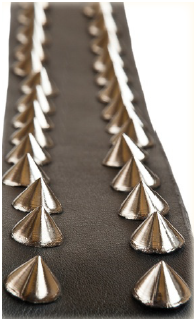1. ChantaDeing was charged with an offence under section 6 of the Control of Weapons Act 1990 (Vic.).
2. The Magistrates’ Court found Mr Deing guilty under section 6 of the Control of Weapons Act of possessing a regulated weapon.
3. Justice Beach had to answer the following questions: is a studded belt considered a regulated weapon, and is wearing the belt a lawful excuse for possessing the studded belt?

4. Justice Beach reached a decision in this case by looking at the purpose of the Control of Weapons Act, which was ‘to regulate weapons other than firearms’. Justice Beach determined that the word “weapon” was not defined in the Act. He looked at dictionary definitions and previous cases to determine the meaning of the word. Justice Beach concluded that the word “weapon” should be defined as “including anything that is not in common use for any other purpose but that of a weapon”. He decided that a studded belt is not a weapon, though it was possible that it could be used as such.
5. In the studded belt case, the court interpreted and applied the words in the legislation made by parliament to the facts of the case. The wording of the legislation was ambiguous or unclear so interpretation of the word “weapon” was necessary. In his judgement, the judge would havereferenced the Act, but gave reasons for his interpretation of the legislation. The reasons for the interpretation of the legislation created a precedent in common law, clarifying the meaning of the word “weapon”.
6. Following the decision, both the Control of Weapons Regulations and the Control of Weapons Act were amended. Now, neither refers to studded belts. In the Act, the terms “regulated weapon” and “prescribed weapon” were changed to “controlled weapon” and “prohibited weapon”.
7. Students should point out that the source of law here is common law. The reason for the decision was made by the judge, Justice Beach, in the Supreme Court of Victoria.
8. Students should point out that the source of law here is statute law. The Control of Weapons Act is law made by the Parliament of Victoria through the legislative process – a bill passed through both houses.
9. Following the discussion of the proposed changes at cabinet, a bill would have been introduced to parliament by a government minister. The bill is likely to have been introduced to the Legislative Assembly (the lower house). Following a number of readings, and possibly consideration in detail, the bill would have been voted on and sent to the upper house (if passed). The bill would have gone through similar stages in the Legislative Council (readings and committee of the whole). Following a vote, if the bill passed it would have been presented to the Governor of Victoria for royal assent. Once the bill was signed by the Governor, it became a law for Victoria.
